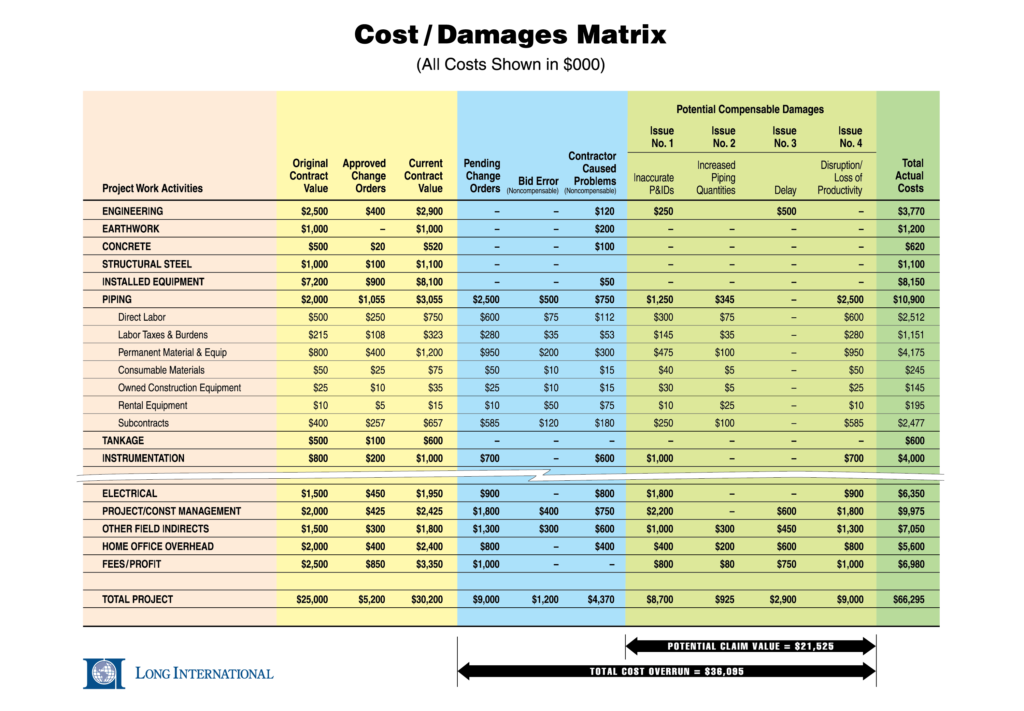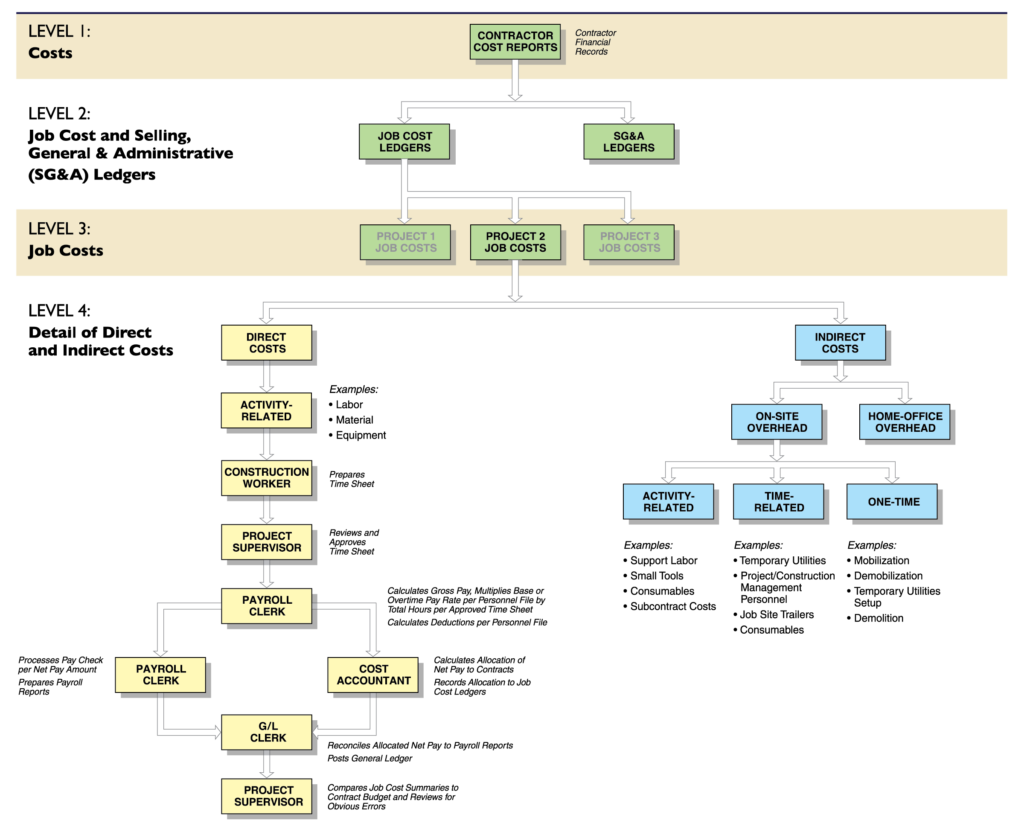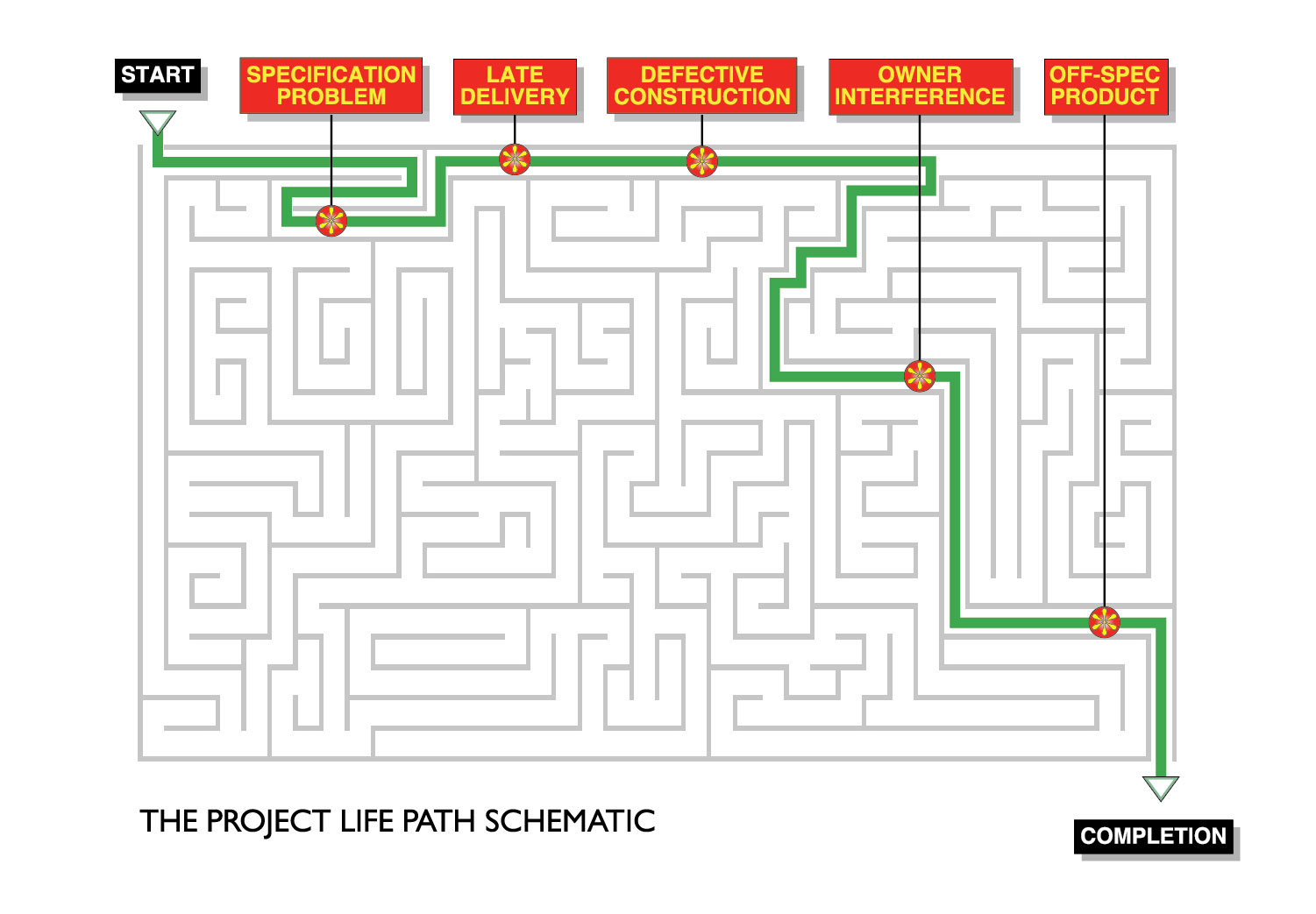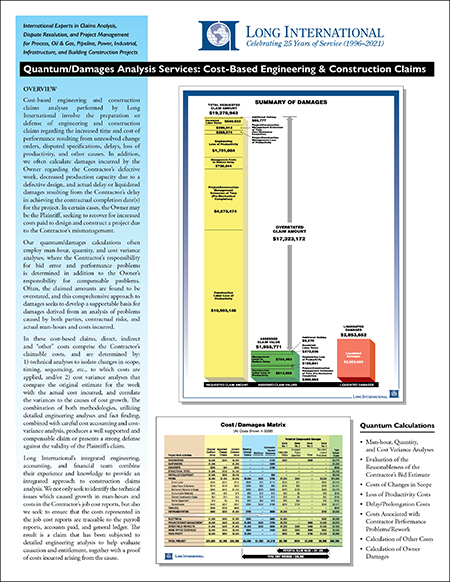
Services
Construction Quantum & Damages Claims Experts
Combining engineering analyses and fact-finding with cost accounting and cost-variance analysis produces a well-supported and compensable claim or presents a strong defense against a claim’s validity.
Our approach integrates engineering, accounting, and financial experts.
Cost-based engineering and construction damages claims address increased time and performance costs resulting from unresolved change orders, disputed specifications, delays, loss of productivity, and other causes. An owner may seek to recover for increased costs to design and construct a project due to contractor mismanagement. Our construction quantum experts calculate the damages incurred by defective contractor work, decreased production capacity due to defective design, and delay or liquidated damages resulting from contractor delays.
Our man-hour, quantity, and cost variance analyses determine a contractor’s responsibility for bid error and performance problems in addition to owner responsibility for compensable problems. With our comprehensive approach to quantum analysis in construction, we seek to develop a supportable basis for damages derived from analyzing problems caused by both parties, contractual risks, and actual man-hours and costs incurred.
In cost-based claims, direct, indirect, and “other” costs comprise a contractor’s claimable costs and are determined by (1) technical analyses to isolate changes in scope, timing, sequencing, etc., to which costs are applied, and (2) cost variance analyses that compare the original estimate for work with the actual cost incurred and correlate the variances to the causes of cost growth. The Cost/Damages Matrix below illustrates the breakdown of costs of various work activities to categories of cost variances between the original contract values and actual costs incurred. Ideally, the analytical results of (1) and (2) equal the same claimable amount, but generally they do not. Differing results arise because the sum of cost components of separately priced claimable events may differ from actual costs incurred when comparing actual costs to the control budget or contract values for each cost component.
Combining engineering analyses and fact-finding with cost accounting and cost-variance analysis produces a well-supported and compensable claim or presents a strong defense against a claim’s validity. Long International’s engineering, accounting, and financial experts join their experience and knowledge in an integrated approach. We not only seek to identify the technical issues that increase man-hours and costs in a contractor’s construction cost reports, but we also seek to ensure that costs represented in job cost reports are traceable to the payroll reports, accounts paid, and general ledger. The result is a claim that has received detailed engineering analysis to help evaluate causation and entitlement, together with proof of costs incurred arising from the cause.

Quantum of Damages Calculations
- Man-hour, quantity, and cost variance analyses
- Evaluation of the reasonableness of a contractor’s bid estimate
- Costs of changes in scope
- Loss of productivity costs
- Delay and prolongation costs
- Costs associated with contractor performance problems and rework
- Owner damages
- Other costs
Engineering and accounting professionals often prepare and review construction cost-based claims. Engineers may focus on man-hours, quantities installed, and costs recorded in project job cost reports. Accountants may focus on man-hours and costs recorded in project cost ledgers and general ledgers. When presenting construction claims in mediation, arbitration, or litigation, testifying fact and expert witnesses may offer evidence as to the quantum of damages from project job cost reports and project cost and general ledgers. Because we integrate engineering and accounting analysis approaches, our construction quantum experts can address the data in all reports and records, which strengthens the basis for a claim.
When increased labor or labor productivity loss are at issue, man-hours and costs in project job cost reports need to correspond to or reconcile with those in accounting ledgers. This is also true for other costs, such as permanent equipment and materials, owned or rented construction equipment, subcontracts, engineering, project and construction management, and other cost accounts.
Proof of costs incurred that arise from the cause takes more than assertion. In addition to proof of cause through detailed engineering analysis, our labor dispute damages experts must establish the propriety of those costs. Costs should be clearly identified by type, with labor categorized by a specific job number, work package, trade, and activity. While some contracts allow for a specified hourly rate for labor, disputed change orders may need to reflect the actual labor cost paid. Also, a labor rate in a project job cost report may not match the actual cost because of payroll tax timing, benefits, and overtime. Payroll taxes may have reached a maximum amount for an individual depending on the time of year when work was performed. Benefits may vary by trade. Some claimed overtime costs may not have been paid if compensation is based on a monthly salary.
Likewise, material costs should be based on actual costs, which can vary over time depending on when materials are purchased, i.e., previously purchased warehoused materials or materials purchased specifically for a project. While overhead or indirect costs may be charged based on a standard rate, actual percentages for overhead often vary, and a construction cost report should include an evaluation of actual overhead or indirect costs.

Challenges in preparing or evaluating the validity of a cost-based claim include identifying the specific costs incurred on a project and determining that a contractor actually incurred the costs. Specific job costs are most easily identified in job cost ledgers and construction cost reports. These reports typically contain direct, indirect, and “other” costs related to project activities over time or at points in time.
Cost verification by our quantum and damages experts is a vital step in preparing or evaluating a cost-based engineering and construction damages claim. A critical step that is often overlooked is determining that costs recorded in job cost ledgers reflect what a contractor actually paid. When costs cannot be shown to have been actually incurred and paid, they may be disallowed and excluded in recovery. Costs per the job cost ledger need to be compared to the contractor’s cash and accounts payable ledgers and reconciled.
Work activity durations, subcontractor use, project complexity, and joint-venture partners may affect the complexity of the work to prepare a supportable cost-based claim. Our integrated engineering, accounting, and financial team of labor dispute damages experts has the experience and knowledge to handle the most demanding claims.

Quantum and Damages Experts: Product Deficiency or Defective Project Performance Claims
Product deficiency and defective project performance claims strike at the bottom line. A business cannot survive if it does not recover its capital and operating costs and make a profit. Our approach to damages quantification integrates the expertise of engineering, accounting, and financial professionals.


